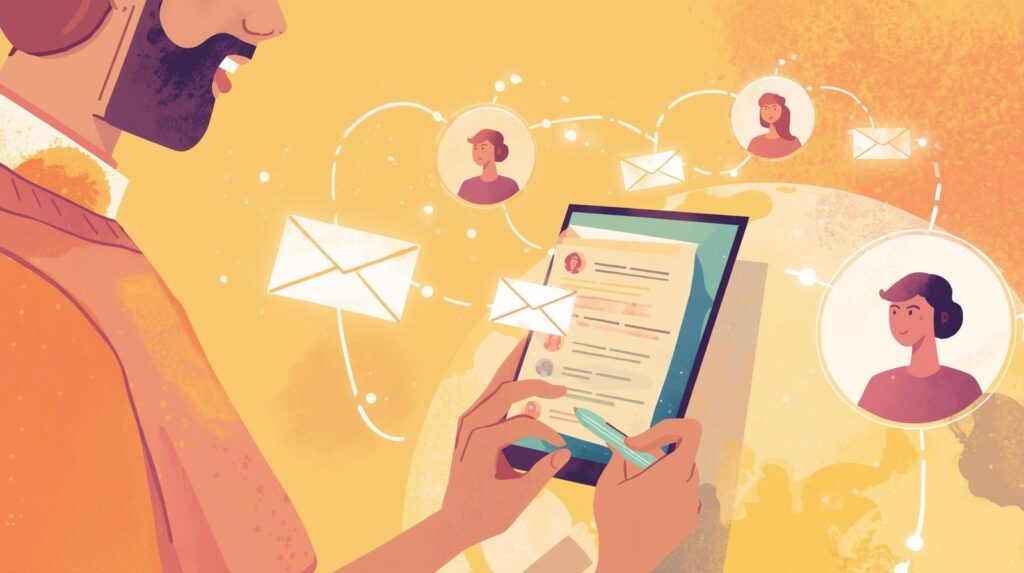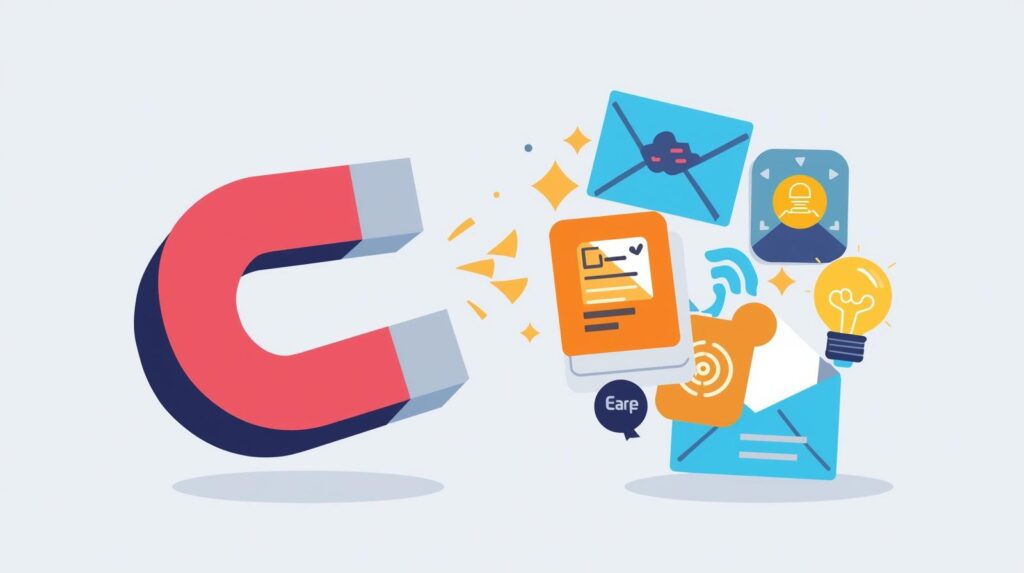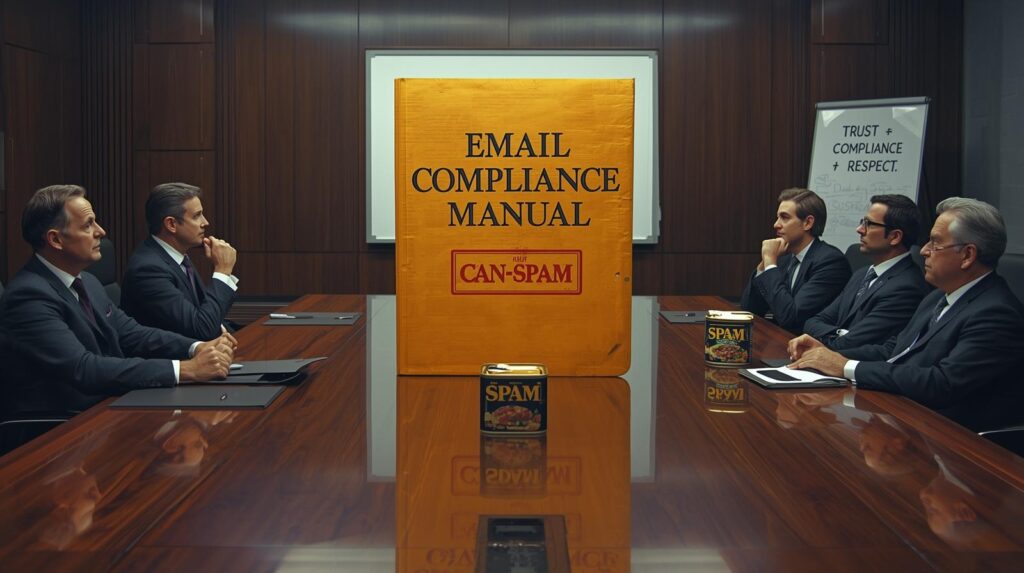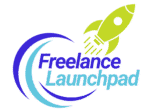Navigating the Freelance Frontier
Starting a freelance business can feel like navigating a dense jungle, full of hidden pitfalls and uncertain paths. New entrepreneurs often find themselves juggling client acquisition, project delivery, and the constant hum of self-promotion. In this challenging landscape, many gravitate towards the immediate buzz of social media, seeking quick visibility and engagement. However, there exists a quieter, more powerful tool often overlooked in the initial scramble: the email list.
Imagine having a direct, unfiltered line to your most interested prospects and clients—a communication channel you fully own, control, and can leverage regardless of fleeting trends or unpredictable algorithm changes. This is the profound promise of an email list. It transcends being merely a marketing tool; it forms the bedrock of a sustainable, resilient freelance business. This guide will cut through the noise, showing precisely why an email list is a freelancer’s superpower and, more importantly, how to start building this invaluable asset from day one. The discussion will explore the evidence, debunk common misconceptions, and provide actionable steps to ensure that new freelancers are not just surviving, but truly thriving.

Why Email is Your Freelance Superpower: Unpacking the “Why”
Beyond the Algorithms: Owning Your Audience
In the contemporary digital landscape, social media platforms are undeniably powerful for broad discovery and reach. They offer avenues for showcasing work, engaging with communities, and attracting new eyes to a brand. However, these platforms operate on what is often termed “rented land.” A freelancer’s visibility, reach, and even their fundamental ability to connect with their audience are entirely at the mercy of ever-changing algorithms and platform policies. A post that garners significant attention today might vanish into the digital ether tomorrow, its reach throttled by an unseen adjustment.
In stark contrast, an email list represents an owned asset. When someone subscribes to a freelancer’s email list, they are providing direct permission to enter their inbox. This grants direct access to subscribers without third-party gatekeepers. This direct, personalized line of communication allows for genuine one-on-one interaction and the cultivation of deeper relationships, a stark difference from the often noisy and transient nature of social media feeds. This direct connection means messages are significantly more likely to be seen and engaged with by an audience that has explicitly invited communication.
The lack of control over audience reach due to unpredictable social media algorithms poses a core problem for freelancers. This unpredictability creates inherent business instability, as a sudden algorithm shift can decimate a freelancer’s lead flow. Email marketing, by providing direct access to an owned audience, fundamentally shifts this dynamic. It transforms marketing from a reactive, platform-dependent activity into a proactive, controlled asset. This means freelancers can construct a more resilient business model, one less vulnerable to the whims of external platforms, ultimately leading to more predictable lead generation and a more stable income, which is paramount for those just beginning their freelance journey.

email delivers reach
– Ramsay Leimenstoll
“A small list that wants exactly what you’re offering is better than a bigger list that isn’t committed”.
The Unbeatable ROI: Your Smartest Marketing Investment
Email marketing consistently demonstrates an outstanding return on investment (ROI). Research indicates that it generates between $36 and $40 for every dollar spent, with some reports showing even more impressive returns, such as Omnisend’s US merchants experiencing an average ROI of $68 for each dollar invested. This performance significantly outperforms most other digital marketing channels. Notably, automated emails, which require initial setup but then run autonomously, show dramatically higher conversion rates and revenue generation compared to standard campaigns.
For freelancers, especially those just starting out, budget constraints are often a primary concern. Email marketing proves to be highly cost-effective, maximizing returns with minimal investment. Many reputable email marketing service providers (ESPs) offer generous free plans, enabling beginners to initiate list building without significant upfront costs.
The impressive ROI of email is not merely a statistical anomaly; it is a direct consequence of its inherent advantages. When an individual opts into an email list, they have already expressed a level of interest, making them a “warmer” lead than a casual social media follower. This pre-qualification, combined with the powerful ability to segment and personalize content based on subscriber behaviour and preferences , ensures that messages are highly relevant to the recipient. This relevance naturally leads to higher engagement and conversion rates. The deeper implication here is that email marketing effectively leverages trust and targeted communication to create a compounding effect: each valuable email strengthens the relationship, making subsequent offers more likely to convert, thereby driving the observed impressive ROI.
Building Trust and Loyalty: More Than Just a List
Email allows for a more personal and intimate connection than public social media posts. It creates a dedicated space where a freelancer can share unique insights, offer exclusive content, and foster a genuine community around their expertise. This consistent, valuable communication is fundamental to strengthening customer relationships over time.
An email list serves as an exceptionally powerful nurturing tool. It enables a freelancer to guide prospects systematically through their journey, from initial interest to becoming a loyal, paying client, and even an enthusiastic advocate for their services. By consistently providing value and offering solutions to their audience’s problems, a freelancer effectively positions themselves as a trusted expert in their field.
Freelancers frequently encounter the challenge of differentiating themselves in a crowded marketplace. While social media can offer broad visibility, email allows for the development of a much deeper, more nuanced narrative. By consistently delivering helpful, actionable information and generously sharing their expertise , freelancers cultivate an image not just as a service provider, but as a “likable expert”. This approach is not about aggressive selling; it is fundamentally about leading with value. The underlying benefit is that this trust and expert positioning, meticulously built through consistent email communication, significantly reduces the sales cycle and dramatically increases client retention, making future client acquisition efforts both easier and more sustainable.
The Efficiency Engine: Automate and Elevate
One of the most common apprehensions for new freelancers regarding marketing is the perceived time commitment. Email automation, however, emerges as a transformative solution. It allows for the setup of automated sequences, such as welcome emails for new subscribers, nurturing flows that guide prospects through their journey, and even re-engagement campaigns for inactive subscribers. These sequences run in the background, ensuring consistent communication without requiring constant manual effort.
Automated emails consistently demonstrate significantly higher open and click rates, and notably astounding conversion rates, when compared to regular, manually scheduled campaigns. They ensure that every new subscriber receives a consistent, high-quality introduction to a freelancer’s brand and services, meticulously laying the groundwork for future engagement and sales.
A freelancer’s time is arguably their most valuable asset. The challenge lies in providing personalized attention to a growing audience without becoming overwhelmed. Automation effectively addresses this by enabling the pre-definition of messages and rules, which then deliver tailored content based on specific subscriber behaviour. This capability goes beyond mere efficiency; it represents the ability to scale personalization. The deeper implication is that automation empowers solopreneurs to replicate the sophisticated nurturing strategies typically employed by larger businesses, providing a highly personalized experience to a broad audience without the need for a large team. This maximizes their limited time and resources, directly contributing to business growth.

Laying the Foundation: Starting Your Email List Right (The “How to Start”)
Defining Your Ideal Subscriber: Quality Over Quantity
New freelancers should immediately discard the misconception that a massive email list is a prerequisite for success. The truth is, a smaller list composed of highly engaged readers who are genuinely interested in what a freelancer offers is far more valuable than a sprawling, unengaged list. High open and click rates, indicative of an engaged list, are the true drivers of conversions and business growth.
Before even considering sign-up forms or content, it is crucial to achieve crystal clarity on the ideal audience to serve. What are their specific pain points? What problems can the freelancer uniquely solve for them? The email list should be viewed as an “invitation to a party,” not a petition, with a focus on cultivating quality connections over sheer quantity. It is also important to remain flexible and receptive to feedback, as an audience may evolve over time.
For a beginner freelancer, resources, particularly time and money, are limited. Chasing a large, unengaged list is a significant drain on these precious resources, often leading to low ROI and considerable frustration. By instead focusing intently on a specific niche and prioritizing quality over quantity, freelancers can concentrate their efforts on attracting subscribers who are genuinely interested in their unique solutions. The underlying benefit is that this strategic focus not only conserves vital resources but also establishes a more sustainable and profitable business foundation, as engaged subscribers are significantly more likely to convert and become long-term clients.
Crafting Irresistible Lead Magnets: What to Offer
To effectively encourage individuals to join an email list, a freelancer must offer something genuinely valuable in return—a “lead magnet”. This is not merely a freebie; it serves as a tangible demonstration of expertise and a direct solution to a specific problem faced by the target audience.
Lead magnets can manifest in numerous practical forms, catering to various learning styles and needs:
- Checklists, Infographics, or Mind Maps: These provide quick, actionable resources that simplify complex processes or information.
- Written or Video Tutorials: Step-by-step guides that teach a specific skill or offer a solution to a particular challenge.
- PDF E-books or Reports: More in-depth explorations of a topic, such as a specialized recipe guide, a practical workbook, or a concise research paper.
- Mini-Courses or Webinars: These offer a taste of a freelancer’s coaching or teaching style, designed to solve a specific, immediate problem for the audience.
- Exclusive Podcast Episodes or Audio Guides: Valuable content for those who prefer to consume information audibly, offering unique insights or meditations.
- Quizzes: Engaging interactive tools that help individuals understand their needs, assess their personality, or clarify their goals.
A thoughtfully designed lead magnet functions as a strategic filter, not just a gift. By offering a solution to a specific, often painful problem that the ideal customer struggles with , a freelancer attracts highly relevant leads. This process effectively pre-qualifies them, ensuring that those who opt-in are already interested in the very problems the freelancer’s services are designed to solve. The deeper implication is that the lead magnet acts as an initial, low-stakes “proof of concept” for a freelancer’s expertise, establishing authority and building trust before any sales pitch is made, which significantly increases the likelihood of future conversions.
Choosing Your Digital Home: Email Service Providers for Freelancers
While the temptation to use a personal email client like Gmail for marketing might arise, for professional email marketing, a dedicated Email Service Provider (ESP) is absolutely essential and non-negotiable. ESPs ensure professionalism, facilitate compliance with crucial anti-spam laws (such as providing automatic unsubscribe features), and offer indispensable tools for managing subscriber lists, automating email sequences, and tracking performance metrics.
When selecting an ESP, several key features warrant careful consideration:
- Ease of Use: A drag-and-drop editor and an intuitive interface are paramount for beginners to navigate the platform effectively.
- Automation Capabilities: The presence of pre-built workflows and the ability to set up custom automated sequences is crucial for efficient nurturing.
- Segmentation: The functionality to categorize and target different groups within the subscriber list enables highly personalized communication.
- Analytics & Reporting: Tools that provide clear data on open rates, click-through rates, and other key metrics are vital for optimizing campaigns.
- Compliance Features: Built-in features that assist in adhering to legal requirements such as CAN-SPAM and GDPR are critical for avoiding penalties.
- Pricing Structure: Many reputable ESPs offer free tiers for smaller lists, making them ideal starting points for new freelancers.
Choosing the right ESP is not merely about sending emails; it is about establishing a scalable and legally compliant marketing infrastructure from day one. Using personal email for marketing is unprofessional and carries significant compliance risks. A robust ESP provides essential built-in automation, segmentation, and analytics , which are critical for operational efficiency and understanding audience behaviour. Crucially, these platforms also manage compliance features like easy unsubscribe options and consent tracking. The deeper implication is that investing in a reputable ESP early on prevents potential legal headaches, ensures email deliverability, and provides the necessary tools to grow and optimize email marketing efforts without requiring constant manual intervention, thereby future-proofing a freelancer’s business.
“A bad email reputation is like a hangover–hard to get rid of and it makes everything else hurt.”
Chris Marriott



Making it Easy to Join: Opt-in Strategies & Placement
It is crucial to ensure that potential subscribers do not have to search for the sign-up form. Making it prominent and easily accessible is key to maximizing list growth.
Effective strategies for opt-in placement and promotion include:
- Website Integration: Embed sign-up forms directly on the freelance website, within relevant blog posts (often as “content upgrades” specific to that content), and even subtly in the email signature.
- Dedicated Landing Pages: Create specialized “squeeze pages” or landing pages designed solely to capture email addresses in exchange for the valuable lead magnet. These pages minimize distractions and focus the visitor on the single goal of subscribing.
- Social Media Leverage: Utilize social media presence by incorporating clear Calls to Action (CTAs) in posts, profile bios, and even by running targeted advertisements (e.g., Facebook Ads) that direct traffic to the sign-up pages. It is important to remember that social media is “rented land,” so the strategic goal is to move followers to the “owned land” of the email list.
The user experience during the opt-in process must be seamless and pleasant. Avoid intrusive or multiple garish pop-ups that can annoy visitors and drive them away. Ensure the opt-in process is smooth, clear, and sets accurate expectations about what subscribers will receive. If signing up for a freebie also adds them to a marketing list, state this explicitly and transparently to avoid any “bait-and-switch” perception.
For new freelancers, every potential subscriber is precious. The challenge lies in efficiently converting website visitors or social media followers into valuable email leads. Simply having a lead magnet is insufficient; the accessibility and clarity of the opt-in process are critical. By strategically placing forms and crafting clear calls to action, a freelancer can significantly reduce friction in the conversion funnel. The deeper implication is that optimizing this initial “day zero” interaction maximizes the efficiency of lead generation efforts, transforming passive interest into active engagement and meticulously laying the groundwork for future client relationships.

Nurturing Your Network: What to Send and When
The Welcome Wagon: Your Crucial First Impression
The welcome email represents the first and arguably most critical impression a new subscriber will have of a freelancer’s brand. It should be sent immediately after someone subscribes, capitalizing on their peak interest. This initial communication should thank them for joining, briefly introduce the brand, clearly explain what they can expect from future communications (e.g., types of content, frequency, any promotional offers), and, crucially, deliver the promised lead magnet. It is also a good practice to ask them to add the sender’s email address to their contacts to help prevent emails from landing in spam folders.
The nurturing process should not stop at a single email. A well-crafted welcome sequence—a series of automated emails—can systematically introduce new subscribers to a freelancer’s work, share their unique story, and provide additional value over a short period. This sequence sets the stage for a long-term, engaged relationship. The moment someone opts in, their interest is at its highest point. A well-executed welcome email or sequence capitalizes on this immediate engagement. Its purpose extends beyond simply delivering a freebie; it is about establishing the tone for the entire relationship. By being clear, honest, and immediately valuable , a freelancer cultivates anticipation for future emails and builds foundational trust. The deeper implication is that this initial nurturing phase is crucial for reducing early unsubscribes and transforming a casual subscriber into an engaged, loyal follower who genuinely looks forward to receiving communications.
Content That Converts: Educate, Engage, Entertain
The primary focus of email content should consistently be on providing value, rather than solely on selling. The aim is to be helpful, informative, and engaging in every communication. A useful guiding principle is to consider: “What do I wish every client came to me already knowing?”.
Ideas for crafting engaging and valuable content include:
- Educational Content: Offer solutions to common problems related to the freelancer’s services, thereby positioning them as a trusted source of information and expertise.
- Tips and Tricks: Provide actionable advice, quick wins, or “nuggets of expertise” that subscribers can immediately apply.
- Success Stories/Case Studies: Highlight how the freelancer’s work has positively impacted other clients, offering tangible proof of value.
- Industry Insights/News: Curate and share relevant updates, trends, or thought leadership from the industry, demonstrating ongoing expertise.
- Product Explainers/Updates: Clearly articulate how specific services or new offerings benefit clients, focusing on outcomes rather than just features.
- Exploratory Emails: Engage subscribers by asking about their challenges or preferences, allowing for the tailoring of future content to their specific needs.
- Personal Anecdotes: Share relatable stories, even seemingly mundane ones (like a shopping trip to Costco, as one expert suggested ), to build a personal connection and showcase personality.
- Q&A Format: Address frequently asked questions from the audience, providing direct and helpful responses.
Many beginners fall into the trap of constant selling in their emails. However, research consistently emphasizes the strategic importance of providing value first. This approach is not just a best practice; it is a long-term strategic play. By consistently solving problems and offering helpful information, a freelancer builds a reservoir of goodwill and trust with their audience. The deeper implication is that this “value first” approach transforms an email list from a mere sales channel into a powerful relationship-building engine. When an offer is eventually made, it is received by an audience that already perceives the freelancer as a helpful expert, leading to significantly higher conversion rates and stronger client loyalty.

Smart Segmentation & Personalization: Speaking Directly to Their Needs
One of email marketing’s most powerful capabilities is the ability to segment an audience and personalize content. This involves dividing the subscriber list into smaller, targeted segments based on interests, past behaviour, demographics, or even their stage in the client journey. The impact of personalization is significant; personalized subject lines alone have been shown to increase open rates by 26%.
Leveraging data is key to understanding and serving an audience better. Freelancers can track which links subscribers click, what content they engage with, or even ask them directly through surveys within emails. This data provides invaluable insights, enabling the freelancer to send highly relevant content that speaks directly to specific needs and interests, which in turn leads to higher engagement rates and stronger relationships.
Sending generic emails to an entire list is an inefficient approach that often results in low engagement. Segmentation and personalization transform email communication from a one-way broadcast into a series of tailored conversations. By understanding and responding to individual subscriber needs, a freelancer creates a sense of being seen and understood. The deeper implication is that this level of targeted interaction fosters a much stronger emotional connection and loyalty, making subscribers feel valued and significantly increasing their receptiveness to a freelancer’s services, ultimately leading to higher conversion rates and repeat business.
The Power of Automation: Setting Up Your Sequences
Beyond the initial welcome sequences, automation can power a wide array of strategic email campaigns. This includes drip campaigns, which deliver a series of emails over a predetermined period, re-engagement sequences designed to reactivate inactive subscribers, and even abandoned cart reminders if a freelancer sells digital products or services directly.
Automation ensures that an audience receives timely, relevant messages without the freelancer having to manually send each one. This frees up valuable time, allowing the freelancer to concentrate on client work and business development, while the email list continues to nurture leads and build relationships on autopilot. It is worth noting that automated emails consistently generate significantly more revenue than other email types.
A common challenge for freelancers is effectively managing a sales pipeline while simultaneously delivering high-quality client work. Automation effectively creates a scalable, always-on sales funnel. By setting up sequences for different stages of the customer journey, a freelancer ensures that no lead falls through the cracks and that nurturing occurs consistently. The deeper implication is that automation empowers a freelancer to operate with the efficiency typically associated with a larger marketing department, providing consistent touchpoints and lead nurturing that would otherwise be impossible with limited time. This directly impacts their ability to scale their business and secure a consistent stream of work.
Navigating the Legal Landscape: Staying Compliant & Building Trust
The Golden Rule: Always Get Permission
This principle is non-negotiable in email marketing. A freelancer must obtain legitimate, explicit permission before adding anyone to their email list. This means subscribers must actively opt-in through a clear web form, check a clearly worded consent box, or provide express verbal permission. It is critical never to assume consent based on receiving a business card, a social media connection, or simply because one has subscribed to someone else’s list.
Avoiding common, yet detrimental, mistakes is paramount:
- Buying Email Lists: This practice should be unequivocally avoided. Subscribers on purchased lists have no prior relationship with the sender, leading to exceptionally high spam complaints and severe, long-lasting damage to brand reputation and sender deliverability.
- Hiding the Unsubscribe Link: The unsubscribe link must be conspicuously easy to find, read, and understand in every email. Attempting to mask or hide it is illegal and will inevitably frustrate subscribers, leading them to mark emails as spam, which further damages sender reputation.
- Bait-and-Switch Opt-ins: Transparency is key. Be crystal clear about what subscribers are signing up for. If a free offer or download includes automatically joining a marketing list, this must be explicitly stated and disclosed upfront to avoid surprising or misleading subscribers.
- Too Many Emails/Irrelevant Content: Honor the frequency promised at the time of subscription and ensure that content consistently aligns with expectations and provides genuine value. Avoid sending a constant barrage of sales pitches or irrelevant filler content.
For new freelancers, the legal aspects of email marketing might initially appear as an intimidating hurdle. However, the consistent emphasis across various regulations (such as CAN-SPAM, GDPR, and others) on permission and easy opt-out mechanisms reveals a deeper, fundamental principle: consumer trust and privacy. By diligently adhering to these laws, freelancers are not merely sidestepping potential fines; they are actively demonstrating respect for their audience’s preferences and data. The underlying benefit is that compliance becomes a powerful trust metric in the eyes of subscribers, leading to higher engagement, significantly lower complaint rates, and a stronger, more ethical brand reputation, which is invaluable for long-term freelance success.
Understanding Key Regulations: CAN-SPAM, GDPR, and Beyond
Freelancers, especially those with a global client base or audience, must be aware of the key anti-spam and privacy laws that govern email marketing. While the full scope of these regulations can be complex, their core principles consistently revolve around consent, transparency, and the recipient’s right to opt-out.
A Simplified Overview of Essential Legal Requirements:
- CAN-SPAM Act (United States): This foundational framework primarily focuses on opt-out mechanisms and preventing deceptive practices. It mandates accurate header information, non-deceptive subject lines, clear identification of the message as an advertisement, inclusion of a valid physical postal address, a clear and conspicuous unsubscribe mechanism, and the prompt honouring of opt-out requests within 10 business days.
- GDPR (General Data Protection Regulation – EU/EEA): This is a more stringent regulation, requiring explicit, freely given, specific, informed, and unambiguous consent (an “opt-in” model) for processing personal data. It also mandates rigorous record-keeping of consent and grants individuals extensive data subject rights, including the right to access and erase their data.
- CCPA/CPRA (California Consumer Privacy Act/California Privacy Rights Act – California, USA): Similar to GDPR in its consumer data rights, this law focuses on transparency and robust opt-out rights for consumers, particularly concerning the sale or sharing of their personal information.
- CASL (Canada’s Anti-Spam Legislation) & PECR (Privacy and Electronic Communications Regulations – UK): These regulations also generally require express consent (an “opt-in” model) for sending commercial electronic messages, though they include some specific exceptions for existing business relationships.
The Implications of Non-Compliance:
Ignoring these critical laws carries significant risks that extend far beyond mere financial penalties.
- Financial Penalties: Fines for non-compliance can be substantial, ranging from tens of thousands of dollars (under CAN-SPAM) to millions of Euros or Canadian Dollars (under GDPR or CASL) per violation. For a freelancer or small business, even a single complaint escalated to regulatory authorities can result in fines that are devastating to operations.
- Reputation Damage: Publicly reported compliance violations can severely harm a freelancer’s brand, leading to significant customer churn and a profound loss of trust within their audience and industry. Consumers are increasingly concerned about how their data is used, and privacy concerns often influence their purchasing decisions.
- Deliverability Consequences: Internet Service Providers (ISPs) and email providers increasingly act as de facto compliance enforcers through their sophisticated deliverability algorithms. Practices that violate regulations, such as ignoring unsubscribe requests, often correlate directly with higher spam complaints, leading to emails landing in spam folders or being blocked entirely. This effectively cripples a freelancer’s email marketing efforts and ability to reach their audience.
Many new freelancers might perceive legal compliance as a reactive burden. However, the increasing consumer awareness of privacy concerns means that proactive compliance transforms into a significant strategic advantage. By visibly adhering to regulations and demonstrating a deep respect for privacy, freelancers can differentiate themselves in a crowded market, building a reputation for trustworthiness and ethical practice. The deeper implication is that this commitment to compliance not only mitigates legal and reputational risks but also fosters a “trust economy” where consumers are more willing to engage and share information, leading to better performance metrics (such as higher open rates and click-through rates) and a stronger competitive position.

Measuring Success & Staying Sharp
Key Metrics to Track: What the Numbers Tell You
To truly understand the effectiveness of email marketing efforts, freelancers must regularly monitor key performance indicators. These metrics provide invaluable insights into audience engagement and campaign success.
- Open Rates: This metric indicates the percentage of recipients who open an email. A healthy open rate (the average for email marketing campaigns is around 36.5% 5) suggests that subject lines are compelling and that subscribers are engaged with the content.
- Click-Through Rates (CTR): This represents the percentage of recipients who click on a link within an email. A high CTR signifies that the content is engaging and that the calls to action are effective in prompting desired behaviours.
- Unsubscribe Rates: This is the percentage of recipients who choose to opt out of the email list. While some unsubscribes are a normal part of list hygiene, a consistently high unsubscribe rate can signal issues with content relevance, email frequency, or unmet expectations set during the sign-up process.
- Bounce Rate: This measures the percentage of emails that could not be delivered to the recipient’s inbox. A high bounce rate often indicates an unclean or outdated email list, which can negatively impact sender reputation.
Email Service Providers (ESPs) typically offer intuitive dashboards that display these metrics. Analysing this data is crucial for understanding what resonates with the audience and identifying areas for improvement. The goal is to use this information to do “more of what works and less of what doesn’t”.
For a beginner freelancer, intuition might serve as their primary guide. However, email marketing platforms provide rich data that, when meticulously analysed, transforms into a strategic compass. It is not merely about understanding what happened, but delving into why it happened (for instance, a low click-through rate on a specific link might suggest a misalignment between the email content and the linked resource). The deeper implication is that this data-driven approach allows for continuous, iterative improvement of an email strategy, converting guesswork into informed decisions. This empowers freelancers to optimize their efforts, ensuring they are consistently providing the most valuable content and maximizing their return on investment.
Adapting and Evolving: Continuous Improvement
Email marketing should be viewed not as a static campaign, but as an ongoing experiment. Continuous adaptation and refinement are key to long-term success.
- Testing, Feedback, and Pruning Your List: Regularly conduct A/B tests on various elements such as subject lines, email content, and even send times to determine what performs best with the specific audience. Pay close attention to direct replies from subscribers and consider implementing surveys to gather direct feedback. It is also vital to regularly “prune” the email list by removing inactive or unengaged subscribers; a smaller, highly engaged list consistently outperforms a larger, less responsive one.
- Staying Current with Email Marketing Trends: The digital landscape is in constant flux. Freelancers should stay informed about new technologies, such as the integration of AI assistance in ESPs for generating subject lines and content , and evolving best practices. This proactive approach ensures that an email strategy remains fresh, relevant, and effective.
The freelance world inherently demands adaptability. Email marketing, rather than being a fixed campaign, should be perceived as a dynamic system that requires constant iteration. The ability to conduct A/B tests , gather direct feedback , and diligently prune inactive subscribers creates a robust and responsive feedback loop. The deeper implication is that this agile approach empowers freelancers to quickly discern what resonates most effectively with their unique audience, discard what does not, and continuously refine their communication strategy. This fosters a highly responsive and effective marketing channel that grows and adapts seamlessly alongside their business and evolving audience needs.
Conclusion: Your Owned Audience, Your Freelance Future
As new freelancers embark on their entrepreneurial journey, it is crucial to recognize that an email list is far more than just a contact database. It stands as a direct, unmediated line to clients, a robust shield against the unpredictable whims of social media algorithms, a powerful driver of revenue, and a foundational element for cultivating enduring relationships. It grants unparalleled control, fosters business stability, and provides the consistent ability to nurture an audience into loyal clients and enthusiastic advocates. In a digital world characterized by fleeting trends and constant noise, a well-managed email list serves as a steady, reliable anchor for a freelance business.
The journey of building a thriving freelance career, much like the journey of a thousand clients, begins with a single subscriber. There is no need to wait for a business to be “established” or “perfect” before starting. Begin building an email list today, even if it’s just with a handful of dedicated individuals. Select a reputable Email Service Provider that aligns with current needs and budget, craft a valuable lead magnet that addresses a specific pain point for the target audience, and commit to consistently providing content that educates, engages, and entertains. The future success and resilience of a freelance endeavour depend significantly on this foundational step.
Your First Steps to Freelance Freedom
